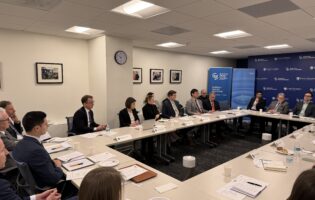Improving the Labor Market Integration of Refugees and other Migrants
On March 14, 2016, AGI hosted a workshop on “Improving the Labor Market Integration of Refugees and Other Migrants” with Liam Patuzzi, Project Officer at the Agency for the Development of Professional Education (ebb – Entwicklungsgesellschaft für berufliche Bildung), and Tamar Jacoby, President and CEO at ImmigrationWorks USA. This workshop focused on the refugee crisis in Germany from an economic perspective, comparing it with economic opportunities in the United States.
Looking at Germany, Liam Patuzzi discussed the evolution of immigration and integration policies and responses, simplifying it into three phases. The first phase in the mid-2000s is when, against the background of a faltering economy and high unemployment (especially among migrants) and after decades of Germany’s self-denial of its status as an immigration society, some crucial integration policy changes took place, such as the Immigration Act in 2005, the first Integration Summit in 2006, and the National Integration Plan in 2007. Before these transformations, integration policy in Germany had been quite piecemeal, with projects that were frequently missing evaluation and coordination with mainstream services. In 2005, the Network IQ was created by the Ministry of Labor, with the goal of improving the labor market integration of immigrants. This goal was pursued by developing innovative services to better meet the needs of migrants, by supporting mainstream service providers (such as employment agencies) with migrant-specific advice and concepts, and by improving the coordination of relevant players and initiatives in order to create solid integration paths.
Phase Two began after Germany’s recovery from the 2008 global financial crisis. Germany’s relatively swift recovery resulted in changed priorities for long-term development. While unemployment was low, so, too, was the forecast population growth, mainly due to the declining birth rate. This discrepancy created concern that Germany’s demographics could not keep up with its workforce—or its welfare state—demands. Immigration started to be increasingly seen as a resource to mitigate existing as well as expected shortages in skilled labor. Several legal and policy changes were enacted in this period to liberalize Germany’s immigration system, including the New Employment Ordinance, the Recognition Act and the EU Blue Card (in force in Germany since 2012, the Blue Card allows high-skilled non-EU citizens to work and live in any country within the European Union excluding Denmark, Ireland, and the UK). In this phase – which in several respects is still ongoing – Germany has made strong and consistent efforts to become more attractive and open to immigration. However, these efforts were targeted mainly at welcoming those regarded as the “right” immigrants, namely the ones bringing formal skills needed in the German labor market.
Since 2015, the start of the third phase, the monumental challenge has been not only the sheer number of refugees streaming into the country, but also how to handle their integration. Given Germany’s previous experiences, Mr. Patuzzi stressed the importance of workforce education and of consistent recognition and validation of labor credentials incoming refugees have in order to systematically build on already existing skills with appropriate and customized training measures. Some urgent steps already taken to promote workforce integration include shortening the time needed to process asylum applications and opening comprehensive employment support services to asylum seekers even before protection is granted, if they have good prospects of being allowed to stay in the country. This “early intervention” is particularly important, because “wasting time” and not offering adequate training and support from the beginning will deeply affect chances of integration in the long run. The strategies for integration start with differentiating the formal versus informal competencies of the refugees. As provisional data and early estimates indicate, the majority of refugees have no formal professional credentials, but Mr. Patuzzi’s optimism lies in the fact that many are young with strong education potential. A comprehensive and flexible language program is another essential step—not just learning basic German, but providing vocational language support. If employers do not play along, vocational programs will not work when it comes to the hiring of refugees.
Tamar Jacoby of ImmigrationWorks USA discussed the American counterpoint to labor integration strategies. Although Germany is one quarter the size of the U.S., it still spends ten times as much on immigration, which will only increase in the coming years. The U.S.’ so-called “advantage” when it comes to integration is a result of historical differences. The United States has a culture of migration backgrounds and embraces the notion of a cultural melting pot. Germany has a different approach to and belief in nationality, identity, and sense of belonging. The U.S. labor market is more flexible and easier to enter than Germany’s. This fluidity is an advantage for migrants in America, as they do not have easy access to welfare like in Germany and therefore need to work. In both countries, the workforce is a crucible for integration for refugees and migrants, as trust built in the workplace can extend into civil society.
Liam Patuzzi is a Project Officer at EBB – Entwicklungsgesellschaft für berufliche Bildung (Agency for the Development of Professional Education) in Cologne, Germany. There, he works in the national coordination office of the Network IQ (“Integration through Qualification”), a federal program aimed at improving the chances of migrants in the German labor market. One of his main tasks is fostering the exchange of knowledge between IQ and international partners. Liam has a strong interest in migration, asylum, and integration policy at the German, European, and international level. A native Italian, he holds a Bachelor’s degree from Ca’ Foscari University, Venice, and a Master’s degree in Social Sciences from the University of Freiburg, Germany.
Please contact Ms. Elizabeth Caruth with any questions at ecaruth@aicgs.org.
Location
AICGS R. G. Livingston Conference Room
1755 Massachusetts Avenue NW Suite 700 Washington, DC 20036 United States







